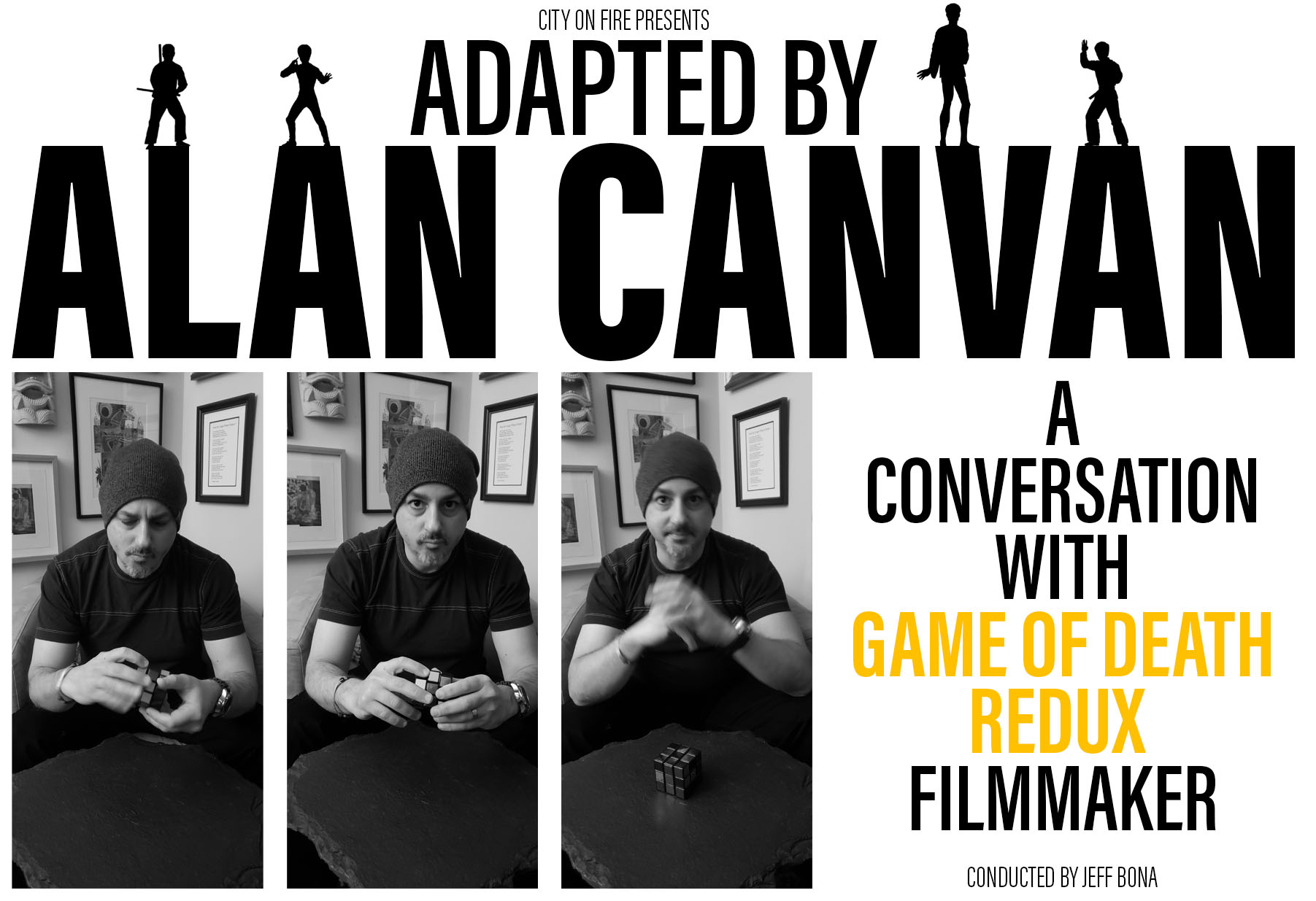
The following is a conversation with indie filmmaker, Alan Canvan. He’s a cinema enthusiast and a quote/unquote “Bruce Lee Historian” (more on that later) who has a different – and very controversial – thought process when it comes to his opinions on Bruce Lee and his films, which was one of the reasons I approached him for this interview.
Alan has hosted a few events, including Bamboo, Nunchucks & Dirty Footprints: A Retrospective of Bruce Lee’s ‘Game of Death’, which was co-hosted by Bruce Lee: A Life. author, Matthew Polly; as well as a private screening for Bruce Lee’s obscure childhood film, The Orphan (1960), which was made possible thanks to Alan’s relentless ability to seek down the film’s copyright holders in Hong Kong. He also has written some in-depth articles in the British Bruce Lee publication BLR and Spain’s BLM magazine.
But what Alan is perhaps mostly known for The Game of Death Redux, which was released exclusively on Criterion Collection’s 2020 boxed set Bruce Lee: His Greatest Hits. The film showcased 23 minutes of the 1972-era Game of Death footage that’s presented closely the way Bruce intended, while at the same time, keeping in-tact some of the stronger aspects of the universally panned, pieced together 1978 film (known to fans as Game of Death ’78), such as John Barry’s acclaimed score, as well some of the film’s strong audio design.
This brings us to his latest project – an updated, new and improved version of Game of Death Redux (aka Game of Death Redux 2.0), which will soon be released to the public. I thought it would be a good opportunity to have a chat about it, as well as many other topics surrounding Bruce Lee and his work.
Enjoy!
JB: Why did you decide to make 2.0?
AC: What’s the adage regarding art never being finished, only abandoned? Yeah. With the initial edit, my focus was entirely on the flow of the piece (i.e., how the shots were cut and how the music drove the narrative.) Artistically, I was satisfied. Technically, there were aspects that bothered me. What I really wanted was a complete visual and sonic restoration. It took over a year to achieve, and I was fortunate enough to work with the right team to arrive at this new version.
JB: For those who have seen the original Redux, what can be expected in version 2.0?
AC: Where do I begin? For starters, the new Redux has been fully restored with a brand-new color grade and audio mix. Additionally, Chris Kent, who looped Bruce’s war cries for Robert Clouse’s Game of Death movie, lent his voice once again to match the audio portions I used from the 1978 film. He did a stellar job. Finally, I reworked a dozen sequences which resulted in a far more concise and dramatic presentation of the narrative. I can honestly say that Game of Death, in any incarnation, has never looked or sounded better. After three years, I can finally put it to rest.
JB: Fully restored? Does this mean you had access to Game of Death’s negatives?
AC: Working with the original negatives would have been ideal, but a film can be restored without scanning the original print. In fact, over the years, quite a few movies have been remastered that way.
JB: We’ve seen John Little’s Warrior’s Journey. We’ve seen Bruce Lee in G.O.D/Art Port. Why should we see Alan Canvan’s Game of Death Redux?
AC: The answer lies in what the viewer hopes to gain from the experience. Redux’s audience are lovers of cinema as an artform. Many people respond to Bruce Lee as an icon, but don’t necessarily see his films as high art – and that’s understandable given that most of his movies were hampered by substandard production values and conventions that were far beneath his talent. The Game of Death 1972 footage benefitted from not having to carry the burden and scrutiny of a full-length feature film. However, what truly differentiates it from the rest of Lee’s cinematic oeuvre is the level of artistry that he brought to the picture: his shot compositions, costume/set designs and fight choreography were truly avant-garde, but that often gets overlooked in favor of the spectacle. My goal is to dispel the broad clichés associated with Bruce Lee and give weight to his cinematic brilliance. Game of Death Redux is really an arthouse film disguised as a Kung Fu flick. In that respect, its worthy of being discussed alongside the cinema of Kubrick and Kurosawa.
“My goal is to dispel the broad clichés associated with Bruce Lee and give weight to his cinematic brilliance.”
JB: So, you’re saying that Redux is more for those Bruce Lee fans who own an Akira Kurosawa collection; than the ones who own the Fast & Furious collection?
AC: The question pigeonholes the viewer. At the end of the day, it’s entirely possible for someone to love Fast & Furious, yet also be moved by Redux.
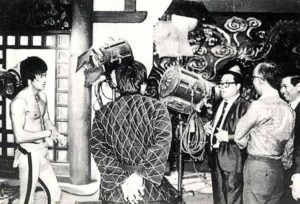
Bruce Lee, Chieh Yua, Raymond Chow and visitors on the set of Game of Death (Source: 36Styles)
JB: The Trailer for Game of Death Redux. Can you explain the voice over?
AC: Some assumed that it was a trailer narrator, but it’s really the American mercenary who befriends Bruce’s character prior to the mission. This role was going to be played by Bob Baker. The V.O. is Kincaid speaking to Hai Tien the night before they leave for the temple. You’re the first to ask me about this, Jeff, so kudos for giving me the opportunity to clarify.
JB: No problem. Is it exclusive to the Trailer, or will it also make an appearance in Game of Death Redux?
AC: I wrote it exclusively for the trailer.
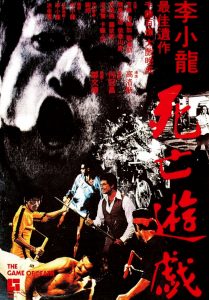
Game of Death Theatrical Poster
JB: You brought back Chris Kent (who dubbed Bruce’s war cries for the 1978 movie) for the Game of Death Redux. Why him? Why not use Bruce’s existing battle cries and/or recreate his sound?
AC: This was a huge sticking point for me with the first iteration of Redux. In retrospect, I feel it was too much of a compromise to go with the hybrid of Bruce and Chris’s voices. The main issue with attempting to apply Lee’s existing war cries from other films to Game of Death is that, tonally, the audio doesn’t match up with his lip movements in the footage. Moreover, audiences are so familiar with those battle cries that, subliminally, it detracts from Game of Death’s identity and comes off as the sonic cut ‘n’ paste job that it is. Many don’t consider the experimental nature of Bruce’s war cries and believe them to have been identical in each of his movies. They weren’t, as he was still in the early stages of developing this personal cinematic vocabulary that was so unique to him. Nowhere is this more evident than in Game of Death, where, often, his expressions are deliberately over the top. Chris’s dubbing for the ’78 film syncs beautifully with the material, and that, to me, superseded attempting to force a square peg into a round hole. And yes, I realize there’s irony in my citing Lee’s unique trademark, only to have another individual voice him. But the spirit of Lee’s work is there, and Chris’s audio for the remaining footage gave the battle cries a consistency that was missing in the previous edit. You’re a huge fan of the 1978 film, so what’s your take?
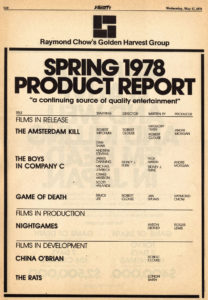
Golden Harvest Variety advertisement promoting Game of Death (1978) and the company’s other Western releases (Source: William Connolly)
JB: Yes. A huge fan of Game of Death ’78. After The Big Boss, it’s my favorite Bruce Lee film, given the fact that I’ve watched it more than almost any existing film I can think of. It fires on all cylinders. Even the rusty ones. For that – and the then-mystery of its flattened ’72 GOD footage – it’s interesting, entertaining and gives me an experience that even a “real” Bruce Lee film can’t compete with. The reason I ask why you brought back Chris Kent is because I’m a fan of every second of “audio” coming from Game of Death ’78, which includes Kent’s battle cries. There’s something “clean as a whistle” about them, especially when compared to Bruce Lee’s own screechy battle cries. And like you said, why take his cries from Enter the Dragon or something and force-fit them in? Totally understandable. The funny thing is when most people do their Bruce Lee impersonation, the sound that comes out of peoples’ mouth sounds more like the cries Kent laid down on Game of Death ’78, than those of Bruce’s real cries from Enter the Dragon.
AC: Agreed, nearly all the war cry impersonators rely on Chris’s voice for reference. I think a big part of the ’78 film’s appeal is that it really plays like a heightened biopic of the last year and a half of Bruce’s life. But it’s the subtle way in which Clouse draws those parallels that impress me. Tiny details, like Billy’s wardrobe choices and photographs of Lee’s childhood films adorning his dressing room, to name a few.
JB: Makes one wonder if organized crime syndicates – wanting a piece of Bruce’s career – was another parallel Clouse might have worked into the “heightened biopic.” Thoughts?
AC: It’s no secret that the entertainment world, on occasion, has had ties to organized crime. Do I believe Lee was being pressed by Triads? Not directly. There are a couple of reasons I say this: First, his rise to superstardom in Hong Kong happened within the span of a year, so we’re talking about a very narrow window of time. Second, Bruce was an American expat living in Hong Kong, and, because of this, it would’ve been significantly more difficult to exert control over his career than it would have with another local celebrity.
“Bruce Lee wanted and needed the world to perceive him as the baddest man on the planet (pre-Mike Tyson!) Through the magic of cinema, he got his wish”
JB: During the peak of his stardom, it was said that Bruce carried a gun, right?
AC: Yeah. And that’s pretty revealing, isn’t it? Who or what did he have to fear? The answer is both simple and complex. A topic that’s rarely, if ever, discussed is the immense psychological effect that fame had on Lee. I’m not referring to the usual pressures of celebrity. Bruce Lee wanted and needed the world to perceive him as the baddest man on the planet (pre-Mike Tyson!) Through the magic of cinema, he got his wish. It put him in a precarious position though, as a great deal of his mental energy became focused on maintaining this illusion to the public. He wasn’t really concerned whether someone could defeat him (Lee felt he was indestructible) as he was alert to the fact that someone could possibly get the drop on him and shatter the myth that he was untouchable. What are the psychological repercussions of attempting to maintain that standard? A heavy toll. Between this and the beginnings of a major drug habit, his paranoia would have been at its zenith. It’s understandable why he felt the need to carry a gun. His is a classic cautionary tale of ‘be careful what you wish for.’
JB: Beginnings of a major drug habit. A gun close by always. Sounds a little like Elvis Presley, especially during his last few years.
AC: There are parallels for sure, even in the near religious zeal of their respective fan bases. But remember, by that time, there was already a widespread wariness in the wake of the Manson murders. In a way, this senseless, horrific act came to symbolize a loss of innocence for America, and many struggled with an existential anxiety in the years that followed. Bruce and Elvis were amongst those affected.
JB: For Game of Death Redux, what kind of character development/backstory did you have for Hai Tien?
AC: I’ve often said that, of all of Lee’s screen characters, Hai Tien comes the closest to Bruce’s real-life persona. I did write a comprehensive backstory for the character to clarify who he was independent of Bruce Lee. During this process, I discovered that, while Hai Tien is Lee’s alter-ego, there are distinct differences between them.
JB: How comprehensive did you get? Novel material?
AC: Not novel, but pretty granular. I did this for all the main characters.
JB: Wow. Can you share more on Hai Tien’s background?
AC: Absolutely. I concluded that Hai Tien was born in Los Angeles to an American mother and Chinese father. He’s the only child to an upper middle-class family that wavered between living in Los Angeles and Hong Kong for a decade, before eventually settling in San Diego around the time Hai Tien began middle school. The experience of growing up in two different cultures has influenced his worldview, just as his rebellious nature has shaped his identity.
JB: That’s interesting. He’s supposed to be a retired martial arts champ, right?
AC: Indeed. He became fascinated with the martial arts at the age of seven but didn’t begin his formal training until he was fourteen years old. At the age of twenty-four he became the lightweight martial arts champion of the world and spent the following six years competing against and defeating the highest ranked fighters in the sport. His level of fame would be comparable to Sugar Ray Leonard’s in the early 1980’s.
JB: The idea that he was “forced to fight” never truly came across on any of the previous versions of the ’72 footage (and it was definitely disjointed from the ’78 narrative as a whole). He looks as though he’s having fun, with no real regard for anyone’s safety on (and in some ways, even off) screen. The smiles. The taunts. The humor. Doesn’t seem like there’s anything on the line for him.
AC: Yes, for me, it was revelatory to look at those characteristics in relation to his circumstances. Similar to Bruce’s original outline, my treatment begins with him recently retired and travelling with his wife and young son (not his sister and younger brother) from Los Angeles to Japan. During a layover in Hong Kong’s Kai-Tak airport, he’s interviewed by the local press, where I emphasize that, although his outward expression and attitude are distinctly American, the people of Hong Kong claim him as their national hero and prodigal son. At the terminal, he’s questioned by a reporter on his reasons for retiring, to which he responds: “Fighting stopped being a challenge. To tell the truth, I can beat anyone in the world.” The second sentence, which was said by Bruce Lee in a magazine interview, intentionally blurs the line, but more importantly, gives acumen to Hai Tien’s character and provides a basis for his metaphysical journey throughout the story. The cockiness he exhibits, in part, is an extension of the psychological armor he has built over a ten-year period of being in the public eye. It’s not a performance per se, rather, a true confidence that’s rooted in competence. What interested me was exploring these facets of his personality in relation to the concept of ego-death, and its subsequent spiritual rebirth, which to me, is the central theme and emotional nucleus of the film. It’s the same story that Lee wrote, only told through the lens of a character study. These elements may or may not have been as relevant to Lee, but they inform me as a storyteller.
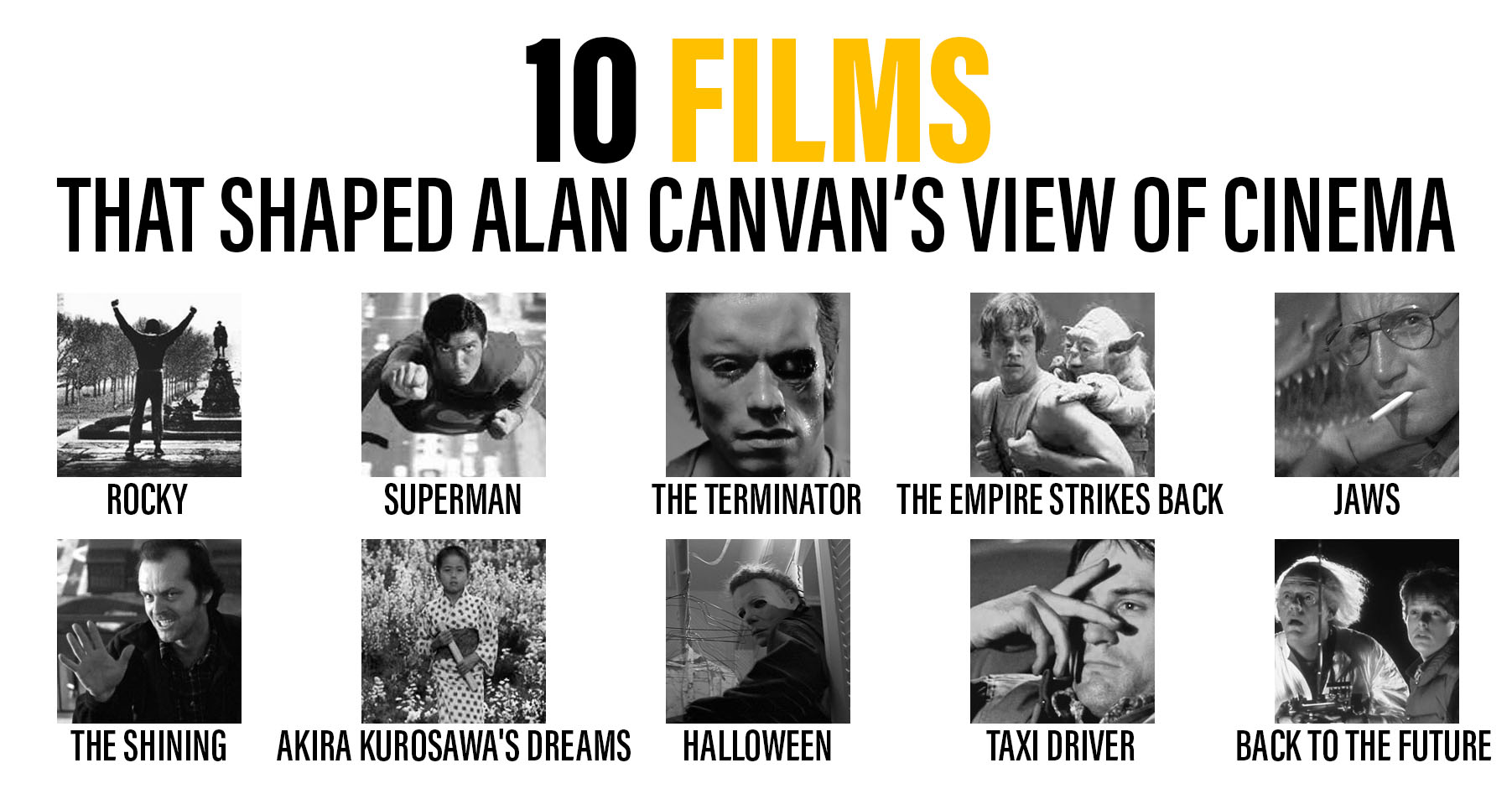
JB: Spiritual rebirth? Hold on, what about all that stuff John Little wrote about, such as the Korean underworld gangs and Hai Tien’s family being kidnapped?
AC: What about it? That was just the set up to get him to the pagoda, and the aspect of the story that least interested Bruce. His true passion was the story inside the pagoda, and he used the structure itself to represent Hai Tien’s unconscious mind. Each hall explores a different layer of his psyche and transforms the setting into a chamber piece with the players never leaving the location and the narrative relying entirely on the performance. I open Redux with a shot of the pagoda in shadow, and sunlight gradually illuminating the temple. This was a deliberate choice. To me, it’s comparable to a stage curtain being drawn back and revealing the setting of a play. It also parallels a moment in the film when Kareem’s character, who symbolically personifies Hai Tien’s dark side, projects the huge Nosferatu like shadow on the wall while removing his gown.
JB: I notice that Bruce and Ji wear similar Asics style sneakers. Is this significant?
AC: I believe it is. Bruce wears two distinct brands of yellow sneakers, neither of which are Asics. Initially, they appear to be, but upon closer inspection they are revealed to be an unknown label that resemble the Panther/Moon Star brands. To me, the sneaker correlation further connects Ji’s character, who assumes the role of the Dragon, to Bruce Lee, whom the Dragon is commonly associated with.
JB: And how about the significance of the gold trim on Ji Han-Jae’s uniform, not to mention him lying in bed, as if he’s waiting for a lover?
AC: Lee deliberately had Ji’s character resting in a reclining Buddha position with his hand and arm supporting his head. In Buddhism, this pose represents the final stage of earthly life before attaining nirvana. This subliminally puts forth the idea that, with each ascending battle, Hai Tien is approaching a spiritual awakening. His emotional truth drives the narrative, but it’s through the physical trials that he attains enlightenment. Bruce specifically designed the gold trim and belt to equate Ji’s character with ancient Emperors, who often claimed the symbol of the Dragon to signify their regality and fierceness.
JB: Even the most diehard of Bruce Lee fans wouldn’t focus on these details and their meanings. To most, it’s another action film, and other than the whole “be adaptable” message, most of this stuff will go over the casual fans head. So, this is the Kubrick part of Game of Death you must be talking about? Also, if we look hard enough, can’t we pull out some Kubrick-like symbolism from any Bruce Lee movie? (Or any movie for that matter)?
AC: I’m certain there are others who fixate on this stuff, but, as you noted, for the majority, the running JKD tutorial in the Hall of the Tiger takes center stage. Few see beyond it and continue to wonder who or what Kareem’s character is meant to be. When Lee spoke of making “multi-level films,” the level of depth in his intent was lost in translation. I stress that in early 1972 Bruce was truly in the process of forming his own personal brand of martial art films. In an interview with Black Belt Magazine, he described The Silent Flute project as “the Easy Rider of martial art films.” This gives tremendous insight into his aesthetic and vision. Could one identify symbolism in Lee’s previous films? Sure. The Coliseum battle with Chuck Norris in Way of the Dragon comes to mind – but only the fight itself, not the movie. I wrote an essay for the latest issue of BLR that addresses the principal themes in The Big Boss, which, from an acting and narrative perspective, is his best film. Neither, however, come close to the subject matter in Game of Death. Going back to your question regarding symbolism being recognizable in any movie, I’ll answer that with a twist on the old standard – it’s not the tale, but he/she who tells it. That’s what differentiates a great storyteller from a mediocre one.
JB: What do you think prompted him to go in the more psychological/spiritual direction, as opposed to say another Kung Fu comedy like Way of the Dragon?
AC: Way of the Dragon was the perfect vehicle for Bruce to discover his strengths and weaknesses as a filmmaker. It allowed him to test the waters without having to contend with the critical reception of a worldwide release. As a film, many of the action scenes work well, but the execution of the larger story falls flat. However, it was innovative in that it created the martial art/comedy sub-genre that Jackie Chan would later go on to perfect. Following his directorial debut, Lee had more confidence as a director to begin revisiting the material he had spent three years developing for The Silent Flute. His initial offering, a script treatment dubbed Southern Fist, Northern Leg, shared DNA with the aborted project: a martial artist faces various physical and psychological trials in his quest to obtain a sacred book that he believes will give him martial enlightenment. Southern Fist, Northern Leg deviates from its predecessor by changing the setting to a Chinese period piece and using the young man’s physical and spiritual training to mythologize the origin of Jeet Kune Do. Game of Death’s pagoda sequence took it a step further by incorporating the Jungian symbolism in Silliphant’s Silent Flute screenplay. Both projects reflect the type of martial art movies he aimed for.
“Way of the Dragon was innovative in that it created the martial art/comedy sub-genre that Jackie Chan would later go on to perfect”
JB: You didn’t mention Fist of Fury?
AC: There’s a reason it’s my least favorite of his movies. In terms of narrative, the beginning of the film is far superior to the slow-moving and fragmented finale. Apart from a few scenes, I find Lee’s Chambara driven performance to be too presentational, and fairly one note. In many ways, it’s the antithesis of the wonderful representational offering he gave in The Big Boss. Having said that, I do love the first battle in the dojo as well as Bruce’s Jerry Lewis inspired telephone technician act.
JB: What are your thoughts on Lee’s acting, in general?
AC: His acting skills have always been eclipsed by his cult of personality. There is a tendency to view Bruce’s screen characters as interchangeable or part of one big continuum because of their shared physical characteristics (i.e., hairstyle, facial gestures, combat stances, war cries.) This has resulted in him never being truly recognized as an actor, but a martial athlete who brought his existing persona to each film. In truth, he was a legitimately versatile performer, who’s commitment to character is apparent throughout all his work. Cheng Chao-Ahn in The Big Boss is radically different from Chen Zhen in Fist of Fury. Way of the Dragon’s Tang Lung is, in part, an ode to Charlie Chaplin. Lee infuses Lee Jun Keung, in Enter the Dragon, with a Steve McQueen swagger that redefines the term ‘King of Cool.’ And with The Orphan, Bruce absolutely slays the rebellious, ‘bad boy with a heart of gold’ archetype with a performance worthy of James Dean.
JB: Speaking of The Orphan, I know you brought the film for a limited screening to the US in 2018. How’d you come to be involved with that?
AC: I first became aware of The Orphan in 1980, after seeing a collection of movie stills in the book Bruce Lee, The Untold Story. The photos caught my attention because they presented Bruce as a sneering young rebel who carried a switchblade and actively sought out confrontations (I’m smiling as I type this, because it’s a reminder of how often life imitates art.) Though tagged as one of his childhood movies, it’s not, given that it was made when he was eighteen years old and legally an adult. Over the years I learned that the film’s copy right holders had no interest in releasing it through conventional media outlets. In 2018, I was able to connect with them through a mutual contact in Hong Kong, and, upon hearing my ideas, they agreed to lend me The Orphan for two screenings that I did in New York and Seattle. It was a wonderful opportunity to reintroduce the picture to US audiences since it first played here the early 1960’s, and, for me, both thrilling and eye-opening to see Bruce’s amazing performance – which gives viewers a much better understanding of the depths of his acting talent.
JB: Another thing you brought back from Game of Death ’78 was John Barry’s score. Was there another soundtrack (from any other artist or any other Bruce Lee film) that you could have sourced? Runners up? Can you elaborate on the teaser’s piano theme as well?
AC: Game of Death is a highly expressionistic piece. Its action possesses a musical, almost lyrical, cadence that relates to Hai Tien’s physical and emotional journey within the story. John Barry’s soundtrack is a master class in how music honors and affects the emotional core of a film. My impetus in creating Redux was contingent on using his score, so no, I never considered another composer’s work. With the teaser trailer, I wanted to musically reflect the story’s central theme. I fell in love with the piano rendition of Barry’s music, which was not only incredibly atmospheric, but complementary to the surreal elements in Lee’s imagery. Stylistically speaking, the teaser does a decent job of distinguishing Redux from its predecessors. I recall you messaging me upon first seeing it. What were your thoughts and how did it affect you?
JB: Being a huge fan of John Barry’s composition for Game of Death, the Teaser trailer for Redux, especially its low/slow tempo, piano-driven take, sent goosebumps up my spine. It’s another example that – even in Trailers – music is one of the legs that holds any moving picture up. The Art Port “guitar” rendition of John Barry’s score, and the lack of John Barry’s composition in Warriors Journey, are those projects’ biggest flaws. With that said, where exactly did you hitch the piano score for the Teaser?
AC: It’s the work of a musician named Hajp, who’s YouTube channel I was fortunate enough to come across a few years ago. Hajp was very forthcoming and happy to be part of the project. He has covered themes from all of Bruce’s adult films, as well as many other popular tunes. If you’re into piano music, I recommend checking his page out.
JB: Earlier, you mentioned a musical cadence to Game of Death. Can you elaborate on that?
AC: Bruce was a dancer, so music was hugely influential on his artistic expression and approach to screen combat. His cinematic battles often had a poetic pulse that guided the subtext within the narrative. I’m certain this aspect of his choreography would’ve continued to develop with each project.
JB: Do you think, if Bruce had completed Game in 1972/1973, that he would have had Joseph Koo to score the film, like some fans seem to believe? It’s not a stretch, given he loved what Koo did in Way of the Dragon.
AC: No doubt, Bruce loved Koo’s score and, as you’re aware, played percussion on the main theme for Way of the Dragon. Predictably, this has led some shortsighted fans to surmise that Koo’s work would have served as the musical template for all of Lee’s movies. This way of thinking governed John Little’s choice of music in Warriors Journey. The inherent problem with that model is that it fails to acknowledge that Bruce was an evolving artist – in the most complete sense of the term – and certainly wouldn’t have limited his palette to one specific style of music. Given that Game of Death was intended for the international market, it’s difficult to see him going with Koo, especially having just come off Lalo Schifrin’s operatic score for Enter the Dragon. Koo’s music, while memorable, was more understated.
JB: Do you think Lee might have eventually used popular music in his movies?
AC: Great question. Stewart Copeland, one of the world’s preeminent drummers, and founder of the rock group The Police, took his artistry to the next level when he began composing for film. His approach to percussion was both unorthodox and personal. I think Lee would have been a big admirer of The Police and seen a lot of himself in Copeland. So, the long answer is, yeah, he probably would have.

JB: If Lee had finished filming the entire pagoda sequence, how do you think those battles would compare to the three we know and love?
AC: My feeling is the ‘Hall of the Praying Mantis’ would have had the potential to be the crown jewel in Lee’s fight choreography. Following the motif of Hai Tien beating each guardian at their own game, this duel would have served as a postmodern critique of his mother art, Wing Chun, with Bruce highlighting many of the modifications he made to the system in the early 1960’s. From a visual perspective, the praying mantis shapes would also have provided a nice artistic touch to the close quarter combat. I should also stress that had Bruce completed Game of Death, the filmed sequence would have been whittled down to an even shorter running time than Redux. With an additional sixteen to twenty minutes of action coming from the two preceding battles, the pacing of the pagoda finale would have been an entirely different animal. Having said that, the short film structure of Redux works well with the footage coming in at a 31:46 run time.
JB: For years, there has been ongoing speculation on what the treasure at the top of the pagoda would have been. Given your attention to theme and symbolism, would you care to throw your hat in the ring on this?
AC: The treasure is the ultimate McGuffin. Many believe that Lee would have taken the ‘mirror book’ idea from the The Silent Flute and applied it to the ending of Game of Death. I don’t think it would have worked. Why? Because that kind of outcome only holds weight if the protagonist’s intent is to acquire the object directly for his or herself. Contrary to this, Hai Tien’s goal is to clear the path that leads to the treasure, and not the treasure itself. His sole concern is the safety of his family. In my script treatment, I give a few thoughts on what the treasure could be, but, fundamentally, I believe it’s far more effective for the audience not to know [similar to the way Tarantino used the briefcase in Pulp Fiction.]
“I don’t consider myself a “Bruce Lee Historian.” The caption has all the makings of an SNL joke. I mean, when it comes to another individual’s life, who can truly lay claim to that title? You either know some shit, or you don’t. But no matter how much you know; you can’t know everything. If the Bob Baker letters taught us anything, it’s that.”
JB: Speaking of Quentin Tarantino, what do you think of his controversial portrayal of Bruce Lee in Once Upon a Time in Hollywood?
AC: I’m a huge fan of Tarantino’s work. I have no issue with the fictitious Cliff Booth besting Bruce in a fight. Even if he weren’t a fictional character, it is possible that he, or someone like him, could have beaten Lee. That’s how it goes in the real world. Where Quentin drops the ball is in his depiction of Bruce’s character as a loudmouth jerk who actively picks a fight with a stuntman on a professional film set.
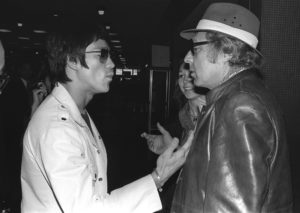
Bruce Lee and Stirling Silliphant.
JB: As with many other “Bruce Lee Historians” – you have a strong opinion on Bruce Lee and his work, particularly Game of Death ’72, with your upcoming Game of Death Redux. With that said, how would you reply to being another “white men in Hollywood trying to tell me who Bruce Lee was”?
AC: I don’t consider myself a “Bruce Lee Historian.” The caption has all the makings of an SNL joke. I mean, when it comes to another individual’s life, who can truly lay claim to that title? You either know some shit, or you don’t. But no matter how much you know, you’ll never know everything. If the Bob Baker letters taught us anything, it’s that. To answer your question, I find it ironic that white men are targeted, given the fact that the individual who said it is three-fourths Caucasian herself (not to mention that her father was Eurasian.) Moreover, it’s insulting to the numerous Caucasians, who were friends, students, and business associates of Bruce Lee. One of them, Jay Sebring, was solely responsible for connecting Bruce to Hollywood. Another, Stirling Silliphant, wrote vehicles to showcase Bruce’s talent in TV and Film. If I’m perceived to be part of that tribe, then I would say I’m in good company.
JB: Makes sense. With that said, do you consider yourself a Game of Death historian?
AC: If I am, it’s by default, not by design.
JB: Have you communicated with anyone who was involved with the previous Game of Death edits?
AC: No, but I was bemused that Bey Logan, of all people, commented on Redux’s trailer, saying something to the effect of, in today’s world, an Asian actor should have voiced Bruce’s dialogue. Given Bey’s history, I find his attempt to be politically correct unbefitting, not to mention contributory to the stereotype that Asians categorically speak a specific way.
JB: How about John Little?
AC: I’ve had no communication with John. I think some people assume that I dislike him when nothing could be further from the truth. I respect his efforts with Warriors Journey.
JB: Are there any specific Bruce Lee project (books, documentaries, commentaries) that you have appreciated lately? If so, can you mention them?
AC: In recent years, there are a few worth mentioning. Matthew Polly’s Bruce Lee: A Life is the best biography on Lee ever written – I’m talking head and shoulders above the rest. I enjoyed Darren Chua and Steve Kerridge’s Mandarin Superstar and Intercepting Fist books which document the making of The Big Boss and Fist of Fury. The Silent Flute book by Marcos Ocana is an excellent window into the creative process of three talented men and their efforts to get the project to the big screen, as well as a candid chronicle of the dissolution of the friendship between Lee and Coburn. As far as documentaries, my favorites remain 1984’s The Legend and 1991’s Curse of the Dragon, though I also dig 1973’s The Man and the Legend and 1994’s A&E Biography. There aren’t many commentaries that hold my attention all the way through, but I did enjoy Brandon Bentley’s take on The Big Boss. It’s the best one out there, thus far.
JB: With regards to James Coburn and Bruce’s friendship – what happened there?
AC: The relationship was complex. The Silent Flute came about during a period when Bruce was on the fringe of achieving his Hollywood dream. He relied on Coburn and Silliphant’s influence in Tinseltown to anchor the project and provide him with a shot at movie stardom. Had it materialized, one of Bruce’s many contributions to the production would’ve been his singular vision for the film’s fight choreography.
Actors, though, are highly competitive by nature, and the sex appeal that Lee exuded when performing combat for the camera would pose a threat to any male co-star – including James Coburn. Not wanting to be outshined by Bruce, Coburn took the precautionary measure of signing on to direct the film to ensure he retained some level of control over the final product.
JB: That’s interesting, I never knew that Coburn was initially going to direct the project.
AC: As the story evolved, Coburn abandoned his directorial aspirations, astutely discerning that the picture needed a seasoned filmmaker to successfully translate the material to the big screen. But the dynamic between Lee and Coburn created its own mini-drama and set the stage for a bad break up between the two men, culminating with Bruce blaming Jim for blowing the deal and expressing regret over partnering with him in the first place. When assessing these events, this also matters: Coburn and Silliphant initially approached Bruce to learn the way of combat – an arena in which they perceived him to be the absolute authority, both physically and philosophically. However, in their pursuit to finance the film, the dynamic of that relationship shifted. In the world of cinema, James Coburn was the Hollywood star, Stirling Silliphant, the award-winning screenwriter and Bruce Lee, the unproven commodity. The deviation in hierarchy was not lost on Bruce, and he was extremely uncomfortable in a situation where he was perceived to be the low man on the totem pole. During their trip to India, Lee lived in the shadow of Coburn’s celebrity among the star struck locals, and often felt powerless in the decision-making process. The experience left him disappointed in Silliphant, resentful of Coburn and less connected to the script. It was a bitterness he would never fully shake, even after his monumental success in Hong Kong. In retrospect, it’s clear that Hollywood’s social scale played a significant role in disrupting their relationship.
JB: Didn’t Coburn visit him in HK to try and get The Silent Flute running again?
AC: When Coburn visited Hong Kong, Lee was more interested in showing off his success to his former student than he was in discussing any future collaboration on The Silent Flute. He reveled in the fact that the tables had turned, and that he was now the one being pursued by Coburn.
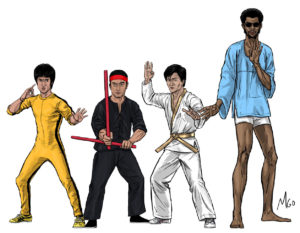
Game of Death fan art by Marten Go of Preserved Dragons.
JB: Did the recent so-called “Drug Letters” change your opinion on Bruce Lee? Would you consider these controversial?
They haven’t changed my opinion in the least. I think much of the shock felt by fans stems from the realization that they can’t know everything there is to know about someone they would love to know all there is to know about. Do I consider the letters controversial? Not especially, no.
JB: Acid. Coke. Mushrooms. Etc. Hundreds of dollars’ worth (thousands of dollars, given today’s inflation). Even Linda Lee was an “accessory”. And you’re saying this is not controversial?
AC: I don’t think the word ‘controversial’ really applies here. I mean, were drugs controversial with Jimi Hendrix and Elvis Presley? Make no mistake, in the last year of his life, Bruce was a bona-fide Rock Star. And he lived the life of a Rock Star. In that respect, he had more in common with Jim Morrison than Lao Tzu. To understand these missives, one must examine the rise of drug culture between 1968-1973, and how it shaped Western society. In the early 1970s, scientifically, we knew much less about the consequences of cocaine than in the “just say no” era that followed. Back then, Hollywood, not only embraced cocaine (despite its illegal status) but actively promoted it as fashionable and desirable. Hard to believe, but true.
JB: And what would you say to those who turned their back on Bruce after reading those letters?
AC: That type of reaction comes from an unhealthy projection and worship of Lee’s screen image. At the end of the day, it’s a misplaced sense of betrayal that’s unfair to everyone involved. Like many before and after him, Bruce was a young man in the process of discovering who he was. He was also quite impressionable – by fashion, music, and cinema. Showbiz exposed him to a few vices. It’s not shocking when viewed through that lens.
“Make no mistake, in the last year of his life, Bruce was a bona-fide Rock Star. And he lived the life of a Rock Star. In that respect, he had more in common with Jim Morrison than Lao Tzu”
JB: If Bruce Lee would have lived after the release of Enter the Dragon, what do you think his next few years would look like in the Hollywood/Hong Kong movie industry?
AC: I don’t think he would have continued to film Game of Death with Golden Harvest. The 1972 footage would probably have never seen the light of day, though it would’ve certainly been used as a blueprint for the big budget version he would’ve made in Hollywood. Based on the success of Enter the Dragon, it’s likely he would have made another film with Robert Clouse. The Shaw Bros. Wuxia project which spawned the famous photoshoot of Lee in various period costumes would have been kicked down the road, if made at all, as its highly doubtful that he would have remained in Hong Kong following the mega success of Enter the Dragon. He may have entertained doing a picture with the Shaw’s after his first box office failure though. Beyond that, I think career-wise he would have been typecast for a while, much like Stallone and Eastwood. And like them, he would have continued to reinvent himself.
JB: So, sequels for Dirty Harry, French Connection, The Godfather and Shaft were made around this time. Do you think Clouse and Lee would have teamed up for a straight sequel to Enter?
AC: It would be difficult to do a worthy sequel to Enter. In many ways, it was the perfect cinematic introduction of Lee to the West and didn’t lend itself to another viable adventure. Would you have liked to see one?
JB: Who wouldn’t like to have seen an Enter the Dragon 2? Han would have some heirs that would set up a nice revenge-driven plot. Despite the complaint that John Saxon gets far too much screen time in Enter is something that could have been fixed in its sequel. Besides, Bruce and John did share some good onscreen chemistry. The bond they develop is made evident in the film’s tail end before the credits roll.
AC: Bruce and John did have great screen chemistry! I will admit to being intrigued by the less addressed dynamic between Lee and Williams. Although the characters never converse with each other, there’s a distinct peripheral awareness, a vibe, that comes across between the two men.
JB: What are some of the biggest misconceptions about Bruce Lee that you think the world needs to know?
AC: Bruce Lee is perceived by most of his fans as a philosopher and a fighter. He was neither. A more accurate description of him would be an incredible performer who studied some philosophy and became an excellent martial artist.
JB: What about the perception of him as a teacher?
AC: Bruce never really enjoyed teaching. What he liked was the reverence it awarded him. That’s what made the experience tolerable. Later, when he became Sifu to the stars, the aim was to impress his A-list Hollywood clientele in hopes of breaking into movies and becoming a star.
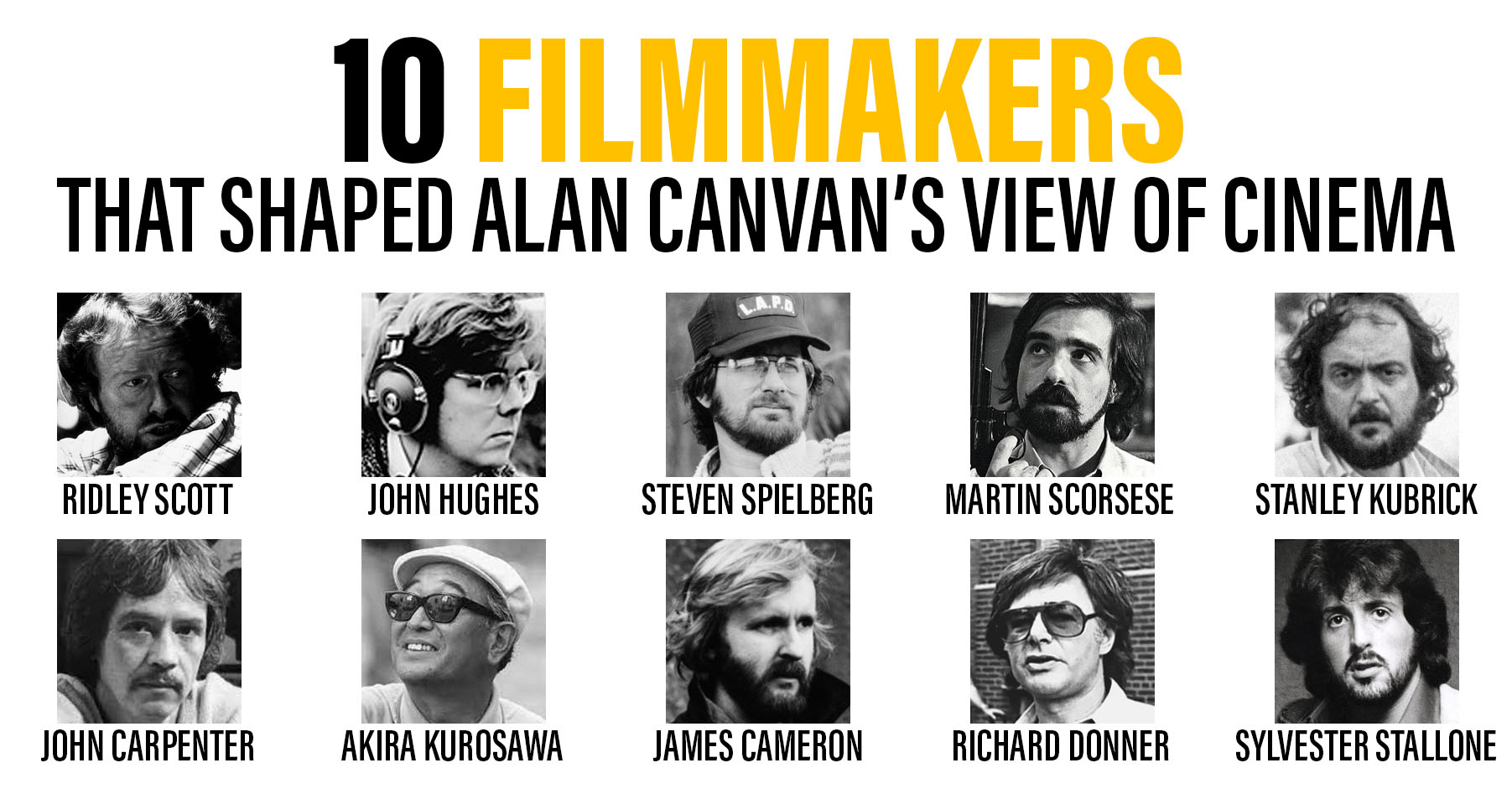
JB: How do you feel about the direction the Bruce Lee Estate has taken with Bruce’s legacy?
AC: They’ve gone to great lengths to create an image of him that’s firmly rooted in the characters he played in Longstreet and Enter the Dragon. Unfortunately, this narrative eschews the wonderfully complex human being Bruce Lee was in real life. The recent documentary Be Water, is a good example of this, only it adds insult to injury by attempting to define Bruce’s entire adult life as a struggle against racism. In doing so, it turns Lee into a caricature and reduces his story to fit the filmmaker’s agenda.
JB: So, I take it you don’t own any hoodies or coffee mugs that read “Be like water, my friend”?
AC: Alas, no. I do, however, own an awesome Daffy Duck baseball cap! How ‘bout you?
“The recent documentary Be Water, is a good example of this, only it adds insult to injury by attempting to define Bruce’s entire adult life as a struggle against racism”
JB: My DVD copy of Bruce Li’s Bruce Lee the Man/The Myth says more than a “Be Like Water” hoodie. If you were given total control of the Bruce Lee Estate, what new directions would you steer it in?
AC: Personally, I would focus more on his cinematic legacy. His process as an actor, choreographer and filmmaker has yet to be fully examined. Even his childhood films. This is crucial to understanding Bruce as a person and as an artist. To me, he remains a 20th Century Dorian Gray figure.
JB: We’ve seen the Teaser for Game of Death Redux. We’ve seen the Trailer for Game of Death Redux. Now, when we will see the Game of Death Redux in its full glory?
AC: I’m thrilled to report that I’m currently working with a prominent UK label that is well known for the standard of excellence it brings to each of its projects. I can’t reveal any details yet, but it promises to be spectacular. I’m sure the usual suspects will be very happy. Tangentially, I’m also in discussions with some of the major streaming platforms. Release dates are still TBD but keep your eye out for some awesome stuff this year.
Thanks again to Alan Canvan for taking the time to have this discussion. Be on the lookout for his upcoming Game of Death Redux (read our review), which will be announced soon. Until then, don’t miss the Trailer for the film below:

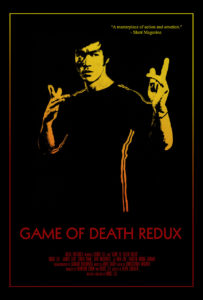
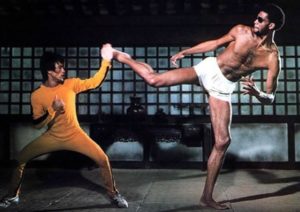

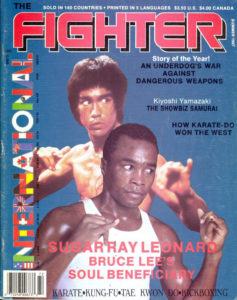
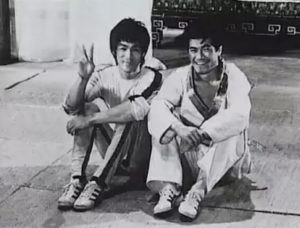


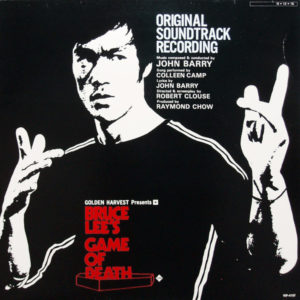
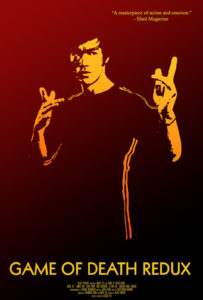

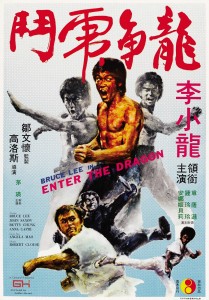


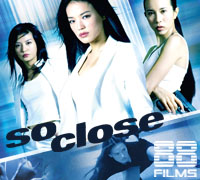
Fantastic interview! Even as someone who has minimal interest in Bruce Lee, this was a great read, and Canvan provides some fresh perspectives on the “what could have been” scenario. The thought of Lee reimagining ‘Game of Death’ as a big budget Hollywood project following the success of ‘Enter the Dragon’ makes a lot of sense, although both the theory that the ’72 footage would likely end up scrapped and that the new production would be helmed by Robert Clouse are equally shudder inducing. Perhaps though the biggest question of all should be, would ‘Stoner’ still have got made as a Lee starring vehicle even after ‘ETD’s’ massive success!? 😛
Have you seen the movie The Ultimate Warrior starring Yul Brynner? It was written & directed by Clouse, released in, I think ’74 or “75. I’d guess that Clouse initially wrote it with the intention of offering it to Bruce, & I think it would’ve been a lot of fun starring Bruce (it’s kind of a Mad Max, post-apocalyptic thing featuring a strong, but mostly silent exotic hero/anti-hero, similar to Eastwood’s The Man With No Name, who fights the bad guys with exotic weapons, no firearms, the bad guy was played by William Smith, he has a one on one fight with Yul Brynner’s character in the end, would’ve been awesome to see tiny Bruce taking on the huge, scary looking Smith!).
The Ultimate Warrior is a great concept take on I am Legend/Omega Man kind of tales
Always love how on various Tai Seng commentaries and interviews, Ric Myers repeatedly claims that Gordon Liu despite being totally unknown in Hong Kong at the time was going to play the lead but Warner Brothers went with Yul Brynner instead
Yeah, while I appreciate Mr. Meyer’s, well, appreciation of Hong Kong cinema & his efforts to bring it to the attention of wider audiences, occasionally he does say something that indicates he doesn’t know quite as much about what he’s talking about as he likes to think he does.
A little self-indulgent, but he undoubtedly knows his shit. I’ll be in line for the G.O.D. Redux.
“A little self-indulgent” ? That’s an understatement…
Great interview, nice job. I would be curious to see the redux out of interest but like Paul, I’ve never been a big Bruce Lee fan. I think Alan goes a little far with his philosophical readings of Bruce’s work. Let’s be honest, they are extremely dated and all versions of Game of Death, so far have been terrible. You summed it up in your digest of Enter the Dragon, a film you want to be awesome but just isn’t. Like everyone else, I would be fascinated to see what Bruce would have done with a higher budget had he lived. Would it have surpassed Sammo’s work on Encounters of the Spooky Kind or The Police Story 2 playground fight, I doubt it.
Awesomeness is in the eye of the beholder, I guess. While I’d agree that guys like Sammo upped the difficulty/complexity level with their fight/action scenes, & Sammo’s films were more entertaining in many ways, with a much wider range of stories, genres, etc., I’d guess that if you asked Sammo about Bruce’s status/abilities as a real life martial artist, Sammo still wouldn’t put himself in Bruce’s league. I realize that being a great martial artist or fighter in real life doesn’t mean you’ll make great martial arts movies (just look at Don Wilson!), but Bruce is THE martial arts icon all these years later for reasons, has there been any other martial arts star who had, what, 10 or so actors & countless producers making money off his image for a decade or so after the original’s death by blatantly impersonating him in countless exploitation (Brucesploitation?) movies?
Very compelling discussions made, Alan really has done his homework into the subject! Be fascinated to know if John Little would ever see this redux. Can’t wait to see the eventual work!
i am looking forward to seeing the full version of this
Alan has some very solid and interesting views, have always wondered ref the story of Bruce carrying a gun in 70’s Hong Kong, as despite the image HK movies have always shown, the actual availability of guns in Hong Kong especially during colonial rule is miniscule, and anyone caught with a gun even during the days of British rule faced very severe penalties and prosecution….
Do agree ref the drug issue, especially Bruce was very much the ‘American’ and despite the New Wave God image that the Bruce Lee Estate seems to want to push when they’re not pimping out his image to sell alcohol etc, Bruce wanted to compete with Mcqueen and Coburn etc in that superstar mentality, and the Bob Baker letters (has the BL Estate ever commented on their content or authenticity?) certainly sell his desire to let off some steam shall we say and play that superstar image to the max
Do find it funny to hear that Bey Logan commented on it not being appropriate to have a westerner voice Bruce Lee, i am guessing if he had been approached to revoice just as he did on the Bruce Lee: GOD that might have been a different story
“has the BL Estate ever commented on their content or authenticity?”
I don’t think so. I find it funny that news of this came nearly a few days after Shannon Lee wet on her “I’m sick of White men in Hollywood rant”, then she went into hibernation as soon as the letters hit. As with the Elvis estate, The Lee estate really wants to keep the God-like image of Bruce Lee in the air. But they forget that it’s their ‘human’ flaws that made them more interesting and relatable. But hey, from a marketing perspective, guess we can’t fully blame them.
Just speculation on my part, of course, but I suspect Game Of Death, had Bruce completed it, wouldn’t have done as well as Way Of The Dragon or Fist Of Fury had. As a martial arts enthusiast & Bruce Lee fan I would’ve loved to have seen the fight scenes he would have come up with but as a movie with a plot, character development, an interesting story, etc., it would have had too much fighting at the expense of everything else. We have roughly 40 minutes of completed fight scenes, there would’ve been, what, about 4 minutes of Bruce fighting Taky Kimura? Plus outdoor footage? Plus Bruce & company fighting guards/karate guys as they entered the pagoda? Out of a 90 or 100 minute film how much time would’ve been left for anything but fighting? And would general audiences have had a clue about anything of any depth Bruce might’ve been trying to share (the whole “be flexible and adapt” thing)?
As for whether Bruce would have actually completed Game Of Death, I see no real reason to think he would’ve abandoned it. Sure, he would have made movies in Hollywood, but didn’t he suggest in his interview with Pierre Burton that he intended to “have his cake & eat it , too”, meaning he’d work both in Hollywood making movies for major studios, & continue to produce his own movies in Hong Kong, too? Like Jackie Chan would do decades later?
“We have roughly 40 minutes of completed fight scenes, there would’ve been, what, about 4 minutes of Bruce fighting Taky Kimura? Plus outdoor footage? Plus Bruce & company fighting guards/karate guys as they entered the pagoda? Out of a 90 or 100 minute film how much time would’ve been left for anything but fighting?”
I think he touches on this in his interview, but good point for sure. Too much action and not enough of everything else is always a bad thing (this happened with The Raid) I think this is why somethig like Cobra Kai works; I know it’s a series, but it might be the best “martial arts film” ever made because its layered story, colorful characters, and it really holds your interest, even though it never really reaches the peak of “great action”. It’s actually reminiscent of some of the best Shaw Brothers films in terms of plot. I really think martial arts films should take a page out of Cobra Kai and hire some better writers and not focus solely on action alone.
i think the fact that Shannon and the Bruce Lee Estate made a point of not commenting on the letters says it all, Shannon is happy to make epic statements such as the “sick of white men’… “Birth of the Dragon is an abomination” because I am not making any money off of it…”But would you like to buy some official Bruce Lee labelled merchandise…if Bruce had used a blender it would have been INSERT NAME BRAND Here’… but oh letters from one of my fathers closest students talking about drugs etc, oh let me say nothing
To be perfectly frank. I find Alans use of Chris Kent is flawed. Firstly because Mr Kent sounds absolutely appalling on the 1978 version of GOD and almost childish. And I remember when the film was released a lot of people were unhappy with it. ” Waaa, Waaaa” and more “Waaa”. Secondly: I have just watched in the UK, the Arrow release of the ‘final Game of Death’ edit featured in their box set ‘ Bruce Lee at Golden Harvest’ And James Flowers has done a magnificent job of inserting Bruce’s original war cries from all his films. They fit the expressions perfectly as does the new voice overs for the dialogues. Its the best ever use of the original footage ever in my opinion. The restoration of the picture quality makes Canvans redux look primitive in comparison.
Those are valid points. I’ve always preferred the sound design (dubbing and music) in 78, which is why I don’t mind Kent’s sounds. I have a review for FINAL GAME OF DEATH coming soon. FINAL looks great, and has some great ideas, but there are some things that I think that are holding it back from being the ultimate GOD experience.